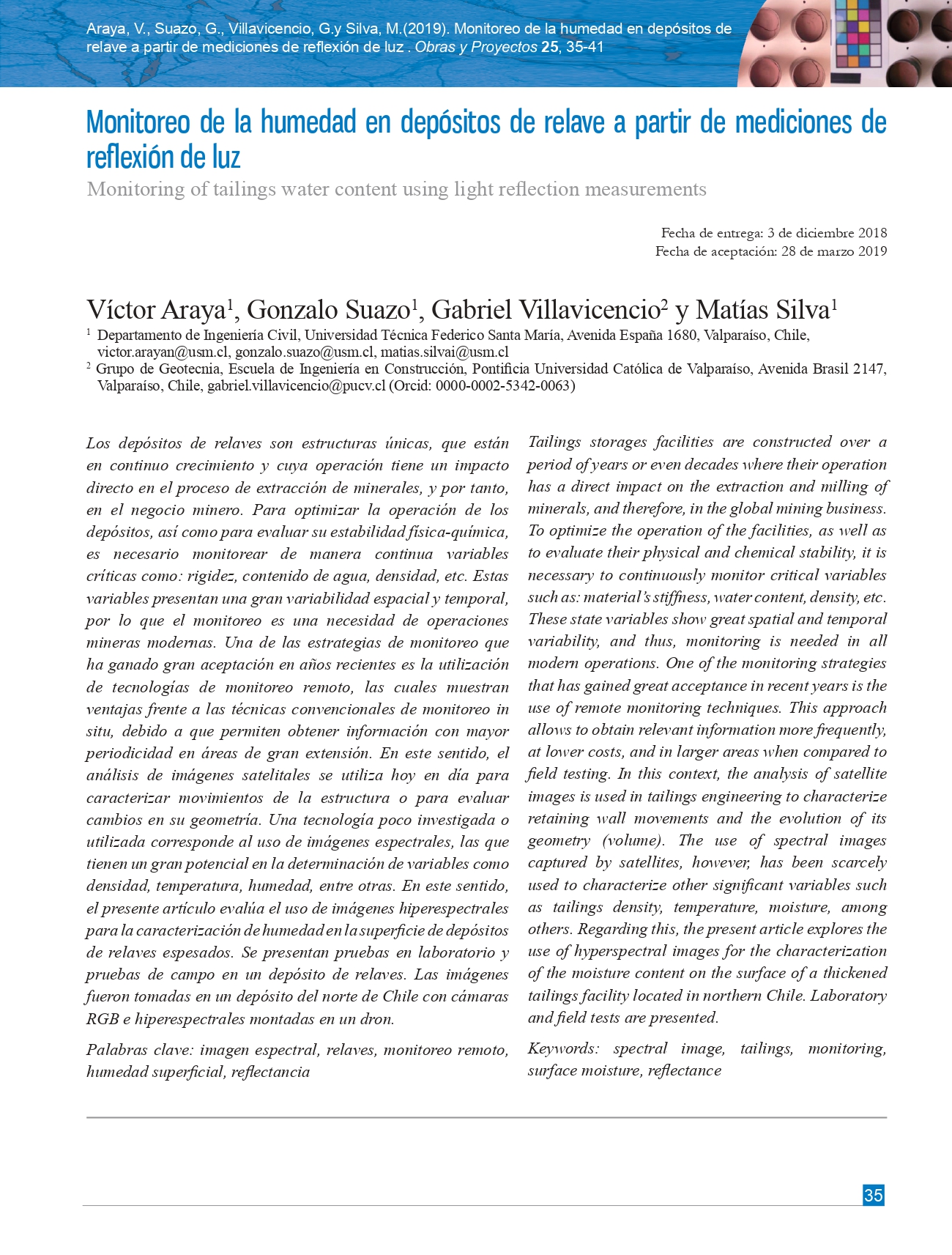Monitoring of tailings water content using light reflection measurements
DOI:
https://doi.org/10.4067/S0718-28132019000100035Keywords:
spectral image, tailings, monitoring, surface moisture, reflectanceAbstract
Tailings storages facilities are constructed over a period of years or even decades where their operation has a direct impact on the extraction and milling of minerals, and therefore, in the global mining business. To optimize the operation of the facilities, as well as to evaluate their physical and chemical stability, it is necessary to continuously monitor critical variables such as: material’s stiffness, water content, density, etc. These state variables show great spatial and temporal variability, and thus, monitoring is needed in all modern operations. One of the monitoring strategies that has gained great acceptance in recent years is the use of remote monitoring techniques. This approach allows to obtain relevant information more frequently, at lower costs, and in larger areas when compared to field testing. In this context, the analysis of satellite images is used in tailings engineering to characterize retaining wall movements and the evolution of its geometry (volume). The use of spectral images captured by satellites, however, has been scarcely used to characterize other significant variables such as tailings density, temperature, moisture, among others. Regarding this, the present article explores the use of hyperspectral images for the characterization of the moisture content on the surface of a thickened tailings facility located in northern Chile. Laboratory and field tests are presented.
References
Dalal, H. (1986). Simultaneous determination of moisture, organic carbon and total nitrogen by infrared reflectance spectrometry. Soil Science Society of America 50(1), 120-123. https://doi.org/10.2136/sssaj1986.03615995005000010023x
Entezari, I., Rivard, B., Lipsett, M. and Wilson, W. (2013). Application of hyperspectral remote sensing in estimation of oilsands tailings water content. 5th Workshop on Hyperspectral Image and Signal Processing: Evolution in Remote Sensing (WHISPERS), IEEE, 1-4. https://doi.org/10.1109/WHISPERS.2013.8080689
Hassan-Esfahani, L., Torres-Rua, A., Jensen, A. and McKee, M. (2015). Assessment of surface soil moisture using highresolution multi-spectral imagery and artificial neural networks. Remote Sensing 7(3), 2627-2646. https://doi.org/10.3390/rs70302627
Hatje, V., Pedreira, R.M., de Rezende, C.E., Schettini, C.A.F., de Souza, G.C., Marin, D.C. and Hackspacher, P.C. (2017). The environmental impacts of one of the largest tailing dam failures worldwide. Scientific Reports 7(1), 10706. https://doi.org/10.1038/s41598-017-11143-x
Taktikou, E., Bourazanis, G., Papaioannou, G. and Kerkides, P. (2016). Prediction of soil moisture from remote sensing data. Procedia Engineering 162, 309-316. https://doi.org/10.1016/j.proeng.2016.11.066
Weidong, L., Baret, F., Xingfa, G., Qingxi, T., Lanfen, Z. and Bing Z. (2002). Relating soil surface moisture to reflectance. Remote Sensing of Environment 81(2-3), 238-246. https://doi.org/10.1016/S0034-4257(01)00347-9

Downloads
Published
Issue
Section
License
Copyright (c) 2019 Universidad Católica de la Santísima Concepción

This work is licensed under a Creative Commons Attribution-NonCommercial 4.0 International License.







